Tell us about your approach to photography. How it all started? What are your memories of your first shots?
Griet Van de Velde (GV): I always loved to look at the small family photo album that my grandfather made. Tiny black and white prints, with lots of snapshots but also those images that wanted to make you believe that they lived in a huge villa and had a nice car, by posing in front of it, even it wasn’t theirs. After some years I understood that even my grandfathers photographs betrayed me and that it was all set up by the photographer, my grandfather himself.
When I was 17 I started to study Photography at the art academy of Gent. To get a place at the academy, we all had to do an entry exam where they asked us what we knew about photography and photographers. My answer was: “Nothing. I came here to study that.” Unbelievable but true… they let me in. I think it was my strength to not have that trained eye and to not feel the weight of all the visual information that can direct one in a certain direction, without first discovering for her- himself. Once started my studies, my first task was ‘light’. I took a photo of our dog, in the dark, in the snow. I still like that image. It’s so naive and therefore beautiful I think.
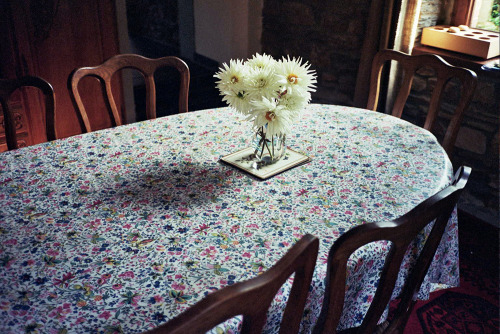
© Griet Van de Velde, Flower on Table, 1999
How did your research evolve with respect to those early days?
GV: Some pupils open up during their art studies and others start to feel limited. I was one of the last ones. After 2 years I stopped my day time studies and continued in evening school, where I could use the studio and dark room. In general we were very free to choose what we wanted to do. After those studies and working a bit too much at the studio, where you can ‘control’ the image, I really wanted to go back to my very first approach of an untrained eye. See it as an adult trying to draw like a child. That was the difficult part.
I bought myself an Olympus compact camera and started to shoot in color. The things around me, daily ordinary things, like my very first shots in black and white. I wanted to get rid of the limitation of working in ‘series’. To get surprised again by a moment of light and shadows that turns ordinary things into poetry or fascinating ordinary installations, made (un)-consciously by the human kind.
The beauty of the position of a waterfall painting next to a cheap hostel room door, with sofa. As it was all made up to get intrigued by what maybe could happen or just happened behind the wall. The moment that the shadow of a tree is projected on a party tent, waiting for her visitors to enter. Those are just two examples of capturing the ‘moment’ on my way, instead of hunting for it. I prefer not hunting for a date, but rather to meet him/her on my way. I learnt that I personally get limited when working in series. It has blocked me for years and doesn’t work for me. So I went back to those early days of my naive eye, but trained by the time and many interesting visual dialogues.

© Griet Van de Velde, Snooker, 2001
What do you think about photography in the era of digital and social networking?
GV: I mentioned before the album of my grandfather. People took photography quite seriously. A portrait was a serious thing that needed time. Lately we’ve been seeing lots of snapshots, shared by social media. Not too much time taken to ‘make’ them, neither ‘share’ them. It’s a wild jungle of images. Maybe that’s one of the reasons I like to find peace in photographs. Even in my own photographs I see this more and more.
Good photography will always survive in the jungle. That photography is maybe seen as an under appreciated art medium, is a fact. There’re lots of good and interesting images ‘accidently’ taken, by untrained eyes. So it seems easy and therefore not taken seriously. Instagram gave us even some filters for free, to give an artistic look to our ordinary snapshots. Suddenly we all became artistic photographers. But that doesn’t have to be a bad thing. Bad thing is that photographs are too much seen on screens. It’s still important, as it is with painting, to see the final product, the print, the frame, the way a photograph is installed, …
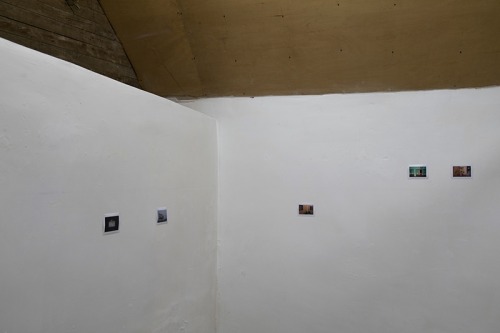
© Installation view Griet Van de Velde
Good thing is that it is much easier now to share your work. While before the social media, one was depending on people who wanted to show his/her work and gave him/her a chance. Urbanautica is an example.
About your work now. How would you describe your personal research in general?
GV: As I mentioned before, my personal research is to stay close to myself. Of course we are all children of our time and we will always be. For me the practice is the research. When I revisit my first photographs and go to my recent ones, I see a naturally grown line, in revealing and concealing, shadows and light on the ordinary, the peace and the claustrophobic directed by my image editing, …
I want that the subject come to me. My initial concern is the photograph, the instance. Too much thinking would lose the naive viewpoint. Planning would go against that.
Do you have any preferences in terms of cameras and format?
GV: As I’m not hunting for images, I need my camera always with me. So I prefer a rather small one, but not compact. I like to control the diaphragm manually.
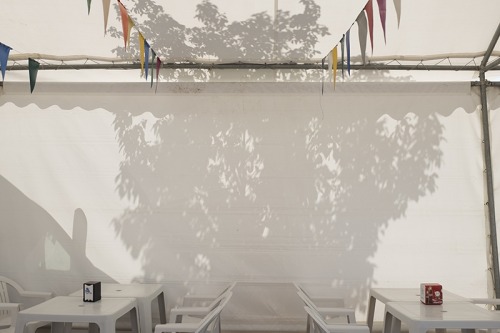
© Griet Van de Velde, Tree in Tent 2014
Is there any contemporary artist or photographer, even if young and emerging, who influenced you in some way?
GV: When I started in late 90’s with my little camera, I discovered the work of Jitka Hanzlova. Her sweet touch to capture the beauty of the simple things in life, her life. The beauty of the village where she was born, but also the beauty of nature in her recent work. The poetry of dawn in the grass she captures, is exceptional for me.
There are two persons that influenced me in the ability to show. One is my boyfriend, painter Carlos Caballero, who insisted that I finally come out with my photos. He gave my work visibility when helping me with my website. This is important these days. Especially when you just start to show works. The other person, is my friend minimal artist Wilfredo Prieto, who convinced me to finally exhibit my work. He selected, together with art historian Lena Solà Nogué, and showed 35 photographs during their stay in Belgium. Their selection of my photographs also helped me to approach my work in a different, more purified way. It was the first time, after all those years of taking photos in silence that my photographs were shown, summer 2014.
Three books of photography that you recommend?
GV: I am not the right person to recommend books of photography. There are so many photographers, and so many good ones that I can’t know all of them… Not every photographer has had the luck that a nice catalogue was published and was distributed widely. Off course we all know the catalogues of the most famous one, Nan Goldin, William Eggleston, Diane Arbus, Joel Sternfeld… and I very much like to look at them.
Is there any show you’ve seen recently that you find inspiring?
GV: A few years ago I saw the solo show of Wolfgang Tillmans in Hamburger Bahnhoff in Berlin. A fresh, inspiring show it was. The way his photographs were represented. Open to experiment and to make your own puzzle out of his photographs. I had the feeling I could make different selections from his choices and make my own selection of his work. I just don’t know if he would like that.

© Installation view Griet Van de Velde
Projects that you are working on now and plans for the future?
GV: I’ll continue my own way, as I said before. But if one day a serie grows naturally, out of a place I stay or people I meet, then a serie it will be.
Concerning showing my work, I can announce that a photograph of mine was chosen for ‘Guest Room: Katrin Weber – Der Greif’ and will be on show for 1 month at Galerie f5,6 in Munich. In May a selection of 5 big prints will be on show at the art gallery EL. My photographs will be shown together with the work of 5 visual artists. A few weeks ago I received the great news from curator Angel Calvo that they invite me for a solo show at art space Miramemira in Santiago de Compostela, opening on June 25th 2015. In July I’ll participate in the Second Room project in Ghent, where they asked me as a curator – artist. I invited 2 young upcoming artists, medium video and installation, to show their work with mine. I am also invited for the Fotorama Window Project, opening end of August. It is a project organized by 2 art collectors and professional printers.
More is coming up, such as a group show with established and upcoming artists, living in Ghent. There is interest in my work in Cuba as well. For the moment, it’s still too early to talk about this. As I mentioned before, I just started to show since summer 2014. It’s all quite new for me and one needs time.
How do you see the future of photography in general evolve?
GV: Digital photography made it easy or easier to work with photographs. Lots of our ordinary photos don’t even get printed anymore. Most photographs are mostly seen on screens. You can take as many as you want and choose the best one. It doesn’t cost you more. There’s no time lost for waiting to see the results. A mistake can be corrected in a moment.
Lately I see a reaction on ‘the fast’ aspect. There is a fresh wind of photographers that went back to the old school - analogue way of capturing and representing. The romance of the dark room is back. To play in the dark room, creating graduates on the paper and so on… Now it’s even fashionable to print on paper again, raw paper. So it all looks a bit more artistic again. In the arts it will be always like this, reaction on the previous wave and action in creating a new one. There was barite paper, plastic photo paper, light boxes, screens and now we go back to the barite paper.
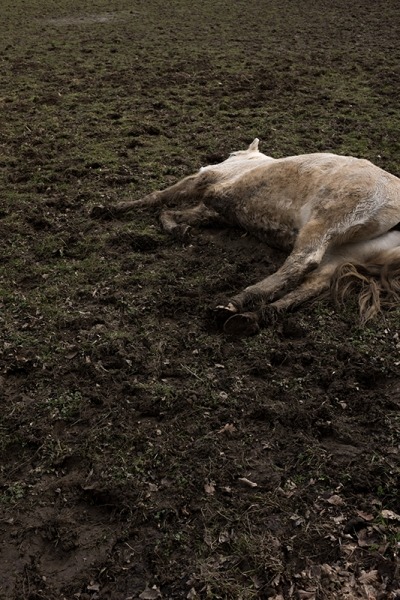
© Griet Van de Velde, Horse Rest, 2015
When I look at your first pics and the more recent; I see an evolution. More sterile pics, can you comment?
GV: You see them as more sterile. I see them as cleaner, maybe more purified, but not sterile. For me there is still the feeling of ‘the abandoned’ and ‘the melancholic’. The type of camera that one uses is off course influencing. My older photographs were taken on film, with that small Olympus camera. Now I’m working with a digital camera and yes I can control more.
During our talk you mentioned you like proofings and just common photo paper? Why? And what is the value to your work?
GV: In the 90’s I always made little proofings of my films. I liked that format a lot, because I could see the photos better than on contact prints. As I was photographing in silence for many years and I never showed my work, I had most of my photographs only on proofings, at home. The day that I was invited for my first show, I liked the idea of showing my proofing formats as I only had seen my photographs in that format for such a long time. In general I love small formats, because it challenges you to go closer and look differently. It sucks you into the image. If you are willing to…
I like common photo paper, because of the same reason I guess. The ordinary. The small. The ones we always had at home. The paper my holiday and friends were represented on. I don’t want to play with ‘the romantic’, by the print. It is already in my photographs. It would be too much of the same and I prefer the contrast.
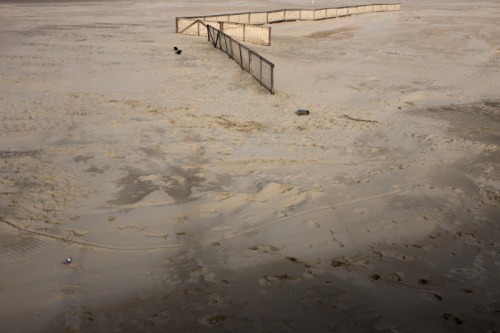
© Griet Van de Velde, Beach Fence, 2015
In your prof career (read S.M.A.K.) you meet a lot of different contemporay artists. Some info on your job? And does this restrict you in any way?
GV: I indeed work for the museum for contemporary art in Gent. My work is organizing art activities for the members of the museum and yes I meet lots of artists at their studio. I’m working between the viewers, creators, collectors and sellers. I’ve been traveling a lot and organizing lots of art travels, in and out of Europe. I’ve had the chance to have interesting conversations with different kinds of artists. My job is not a restriction at all. I love it. I see things differently and can have a better overview than before. There are so many ways and waves and it is all so subjective. It’s a pity that photography is still a bit apart from the contemporary art scene, although it depends on the country.
In Belgium it’s maybe a bit difficult for me to show, as most people know me from the museum. As it is hard for most people to think ‘out of the box’, they have some problems when approaching a photographer. They see me as ‘Griet from the S.M.A.K. museum’, doing photography as her hobby. I don’t understand that way of thinking. If we think of Vivian Maier, being a nanny and taking photos in silence. Was she a photographer or a nanny? That’s not the question anymore. Being a nanny, she maybe felt the freedom of doing what she wanted, without pressure.
---
LINKS
Griet Van de Velde
Belgium
share this page
